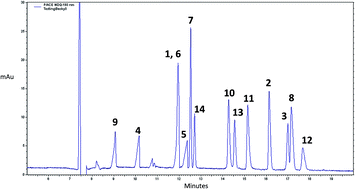A capillary electrophoresis electrospray ionization-mass spectrometry method using a borate background electrolyte for the fingerprinting analysis of flavonoids in Ginkgo biloba herbal supplements
Abstract
A laboratory-built sheath liquid capillary electrophoresis-mass spectrometry interface was used to develop a qualitative method for fingerprinting analysis of 14 structurally similar flavones, flavonols, flavonones, and several representative glycosides in plant samples. The migration order of the flavonoids was dependent on a the number of hydroxyl groups present on the flavonoid B-ring, extent of conjugation, number of glycosidic functionalities, and ability of the flavonoid to form stable borate complexes with the background electrolyte. Parent ion scans of the flavonoids yielded [M − H]−, except for catechol containing flavonoids, which were detected as borate adducts. These adducts can be used diagnostically to determine the presence or absence of catechol groups on unknown polyphenolic compounds. Product ion scans of the flavonoid glycosides and borate adducts typically yielded the deprotonated aglycone fragment as the base peak, which could be used to confirm the base structure of the flavonoid. This method's utility was demonstrated by analyzing flavonoids present in ethanolic extracts of Ginkgo biloba herbal supplements.

- This article is part of the themed collection: In memory of Craig Lunte

 Please wait while we load your content...
Please wait while we load your content...